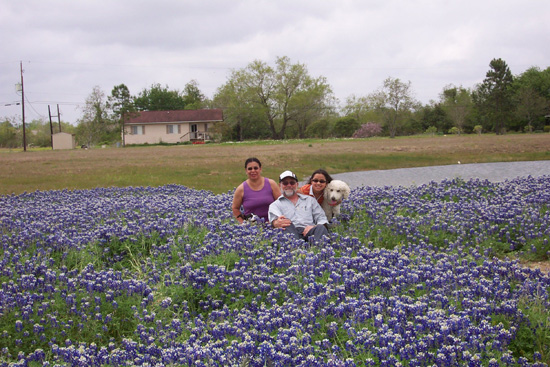Texas State Flower, the Bluebonnet
The Lone Star State, Stetson Hats, Cowboy Boots; All Iconic
Copyright © Kelly Smith; all Rights Reserved; Author’s Google profile Posted December 12, 2012


The Bluebonnet (Lupinus texensis) is the Texas state flower. This beautiful spiked flower seeds itself season after season. Over the course of years, it develops into an expanding field of blue and white.
It prefers sun and well-drained soil. Since this species is a perennial wildflower, it’s not readily found in nurseries, unless you shop at a really good, independent one.
In recent years, specialty nurseries have been selling the seeds. A good time to pick them up is when shopping for vegetable garden plants. If you want another spring-time favorite, Indian paintbrush, you will probably have to transplant them.
Texas Trivia – Texas actually claims five state flowers. The catch is that they’re all varieties of the Bluebonnet!
More Texas Trivia - Those in the know have also been known to call the Bluebonnet “Buffalo Clover”.
Starting a Bluebonnet Garden
The easiest way to start a Bluebonnet garden (either in the Lone Star State or somewhere equally hospitable) is to harvest the seeds from an existing field or order them via snail-mail if they can’t be found locally.
The important thing to remember is that unlike many other flower seeds, they’re not planted in the springtime. They should be planted in August for spring blooms the following year.
This makes sense, because that’s about when the seeds drop off in their natural environment.
The commonly accepted germination rate for Bluebonnets is 66%. But following the first blooming season, the garden will expand annually of its own accord; nature will take its course.
In the Texas Hill Country, in the Austin or San Antonio area, it’s not uncommon to see rolling hills of blue and white, waving in the breeze.
Bright orange Indian paintbrushes provide an eye-popping contrast. And nothing says “Texas yard” like a beautiful Sam Houston Peach tree.
Once they’re established, just mow around them in the spring; don’t mow the flowered part of the lawn until well after they’ve gone to seed. And remember, since they are Texas wildflowers, they don’t like excessive watering or many fertilizer products.
Which Lawns are Best Suited for Bluebonnets?
Although a sunny, well-drained, non-clay lawn is the most important factor for Bluebonnet success, the type of grass they grow in also makes a difference. These wildflowers prefer either a Bermuda grass lawn or zoysia. St. Augustine is not the best choice.
St. Augustine lawns don’t go dormant soon enough in the fall, and in the spring they start growing too soon. This gives the wild flowers too much competition. Bluebonnets typically bloom in late March and early April.
Varieties of Bluebonnet Flowers
Although the typical color is bright blue tipped with a white spike, there are other varieties of Bluebonnet flowers. Dr. Jerry Parsons, of the Texas Cooperative Extension in San Antonio, Texas, developed the “Barbara Bush Lavender” through recurrent selection.
Dr. Parsons also followed the same process to develop the “Aggie Maroon” Bluebonnet. Needless to say, this is a favorite of Texas A&M alumni everywhere. University of Texas Longhorns, not so much.
Then there is the very rare pink Bluebonnet. According to legend, it symbolizes and was stained by all the blood shed by the fallen heroic Texans at the Alamo.
Truth or fiction? Believe it or not, but the fact can’t be denied that the only place they have ever been found is along side of the road, just south of downtown San Antonio...
More Organic Gardening and Food Articles
- Balanced Soil is the Foundation of Organic Gardening
- Swiss Chard — Nutritious Greens or Ornamental for the Flower Garden?
- The Organic Method of Planting a Tree
- Build a Raised Bed Vegetable Garden
